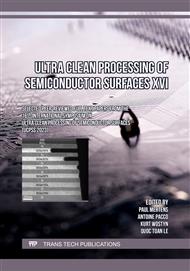p.105
p.111
p.117
p.123
p.131
p.137
p.143
p.149
p.157
Silicon Nitride Selective Functionalization with Aqueous Cellulose
Abstract:
In semiconductor device manufacturing, it is often necessary to process devices that incorporate both Si3N4 and SiO2 with etching solutions. Recently, we found that a cellulose-based polymer (DC01) selectively adsorbs onto silicon nitride and acts as a protective film against etching with buffered fluoric acid. However, the mechanism behind this selective adsorption remains unclear, and a protective film persists after etching. QCM measurements and calculations of the surface free energy indicate that the affinity between DC01 and Si3N4 was significantly stronger than that of SiO2. Notably, the same behavior was not observed with cellulose or cellulose acetate, indicating that this phenomenon is unique to our original cellulose. Additionally, we successfully prepared films using a facile dipping method. Furthermore, we discovered that the strongly adhesive DC01 film can be completely removed by subjecting it to oxidative conditions, such as SC-1 or SC-2.
Info:
Periodical:
Pages:
131-136
Citation:
Online since:
August 2023
Authors:
Keywords:
Price:
Сopyright:
© 2023 Trans Tech Publications Ltd. All Rights Reserved
Share:
Citation:


